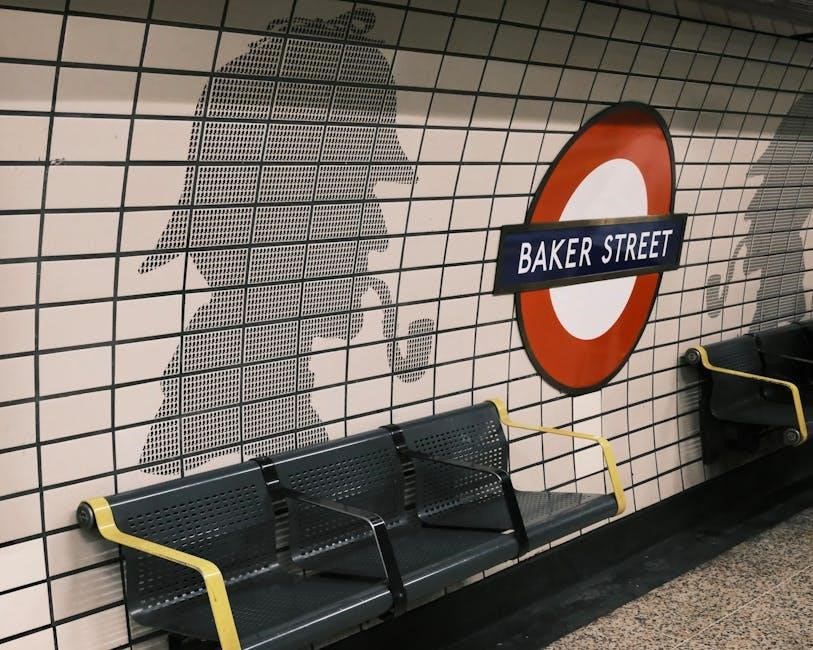Arthur Miller’s The Crucible, published in 1953, is a gripping tragedy exploring the Salem witch trials and their eerie parallels to McCarthyism. This timeless play delves into hysteria, guilt, and redemption, offering a powerful commentary on human nature and societal fear. Its themes of morality, justice, and power dynamics remain universally relevant, making it a cornerstone of modern literature.
1.1 Background of the Play
The Crucible, written by Arthur Miller, was first published in 1953. It is a dramatized account of the Salem witch trials of 1692, blending historical facts with fictional elements. Miller drew inspiration from the paranoia and mass hysteria of the McCarthy era, using the play as an allegory for the Red Scare. The story unfolds in a Puritan community, exploring themes of fear, accusation, and moral collapse. Despite its historical roots, the play’s universal themes resonate across time, making it a timeless critique of societal fear and injustice.
1.2 Publication and Initial Reception
The Crucible was first published in 1953 and opened on Broadway at the Martin Beck Theatre. Initially, it received mixed reviews, with critics drawing parallels to Miller’s earlier work, Death of a Salesman, and the ongoing McCarthy hearings. Despite this, the play gradually gained recognition for its powerful narrative and timely critique of hysteria. Its exploration of universal themes ensured its enduring relevance, solidifying its place as a classic of American literature and a testament to Miller’s mastery of dramatic storytelling.
1.3 Themes and Relevance
The Crucible explores universal themes of hysteria, guilt, and redemption, set against the backdrop of the Salem witch trials. Miller’s play serves as a cautionary tale about the dangers of fear, manipulation, and mass hysteria. Its relevance extends beyond historical events, as it critiques the destructive nature of unchecked power and false accusations. The play’s examination of morality, justice, and human frailty resonates deeply, making it a timeless commentary on societal behavior and the consequences of fear-driven actions. Its themes remain as poignant today as they were during its debut.

Historical Context
The Crucible is deeply rooted in historical events, drawing parallels between the Salem witch trials of 1692 and the McCarthyism of the 1950s. Miller crafted the play during the Red Scare, using the Salem trials as an allegory to critique the hysteria and paranoia of his time. The play reflects the fear-driven societal behavior of both eras, where false accusations and mass hysteria led to devastating consequences. This historical duality underscores the timeless relevance of Miller’s work, serving as a cautionary tale about the dangers of unchecked power and fear-driven actions. The play’s historical context highlights its ability to resonate across generations, making it a powerful exploration of human nature and societal frailties. By examining these events, Miller sheds light on the recurring patterns of fear, accusation, and moral compromise that define both the Salem trials and the McCarthy era. This dual historical lens allows readers to understand the broader implications of the play’s themes and their enduring significance in contemporary society. The Crucible remains a poignant reminder of the destructive potential of fear and the importance of standing against injustice, no matter the cost. The historical context not only grounds the play in real events but also elevates its message, ensuring its continued relevance in understanding historical and modern societal challenges. Through this lens, Miller’s work becomes a vital tool for reflecting on the past and navigating the complexities of the present. The interplay between historical fact and dramatic fiction creates a compelling narrative that continues to captivate audiences and inspire critical thinking about the human condition. The Crucible’s historical context is a testament to Miller’s skill in blending the past with the present, creating a work that transcends time and speaks to universal truths about fear, power, and morality. By examining the historical backdrop of the play, readers gain a deeper appreciation for its themes and their enduring impact on literature and society. The historical context of The Crucible serves as a bridge between two eras, illustrating the cyclical nature of fear and hysteria and the importance of learning from history to avoid repeating its mistakes. This duality of historical events underscores the play’s ability to resonate with audiences across generations, making it a timeless classic in American literature. The Crucible’s historical context is a rich tapestry of past and present, weaving together the Salem witch trials and the McCarthy era to create a narrative that is both historically grounded and universally relevant. Through this historical lens, Miller’s play becomes a powerful commentary on the dangers of fear, manipulation, and the erosion of justice, offering lessons that remain essential today. The play’s historical context highlights the enduring relevance of its themes, ensuring that The Crucible continues to be a vital work in understanding the complexities of human behavior and societal dynamics. The historical backdrop of the play serves as a reminder of the importance of critical thinking and moral courage in the face of overwhelming fear and societal pressure. By exploring the historical context of The Crucible, readers can gain a deeper understanding of its themes and their continued relevance in contemporary society. The play’s ability to bridge past and present events makes it a significant work in literature, offering insights into the cyclical nature of fear and the importance of standing against injustice. The historical context of The Crucible not only enriches the narrative but also underscores the universal truths that Miller aimed to convey, ensuring the play’s continued resonance with audiences today. The Crucible’s historical context is a powerful reminder of the dangers of fear and hysteria, serving as a cautionary tale that transcends time and continues to resonate in modern society. By examining the historical events that shaped the play, readers can appreciate the depth of Miller’s critique and the enduring relevance of his message. The historical context of The Crucible is a testament to the play’s ability to speak to universal human experiences, making it a timeless work in American literature. Through its historical lens, the play offers a compelling narrative that continues to inspire critical thinking and reflection on the human condition. The Crucible’s historical context is a rich and complex exploration of past events, ensuring its continued relevance and impact on audiences today. By understanding the historical backdrop of the play, readers can fully appreciate the depth of Miller’s themes and their enduring significance in contemporary society. The historical context of The Crucible serves as a bridge between two eras, illustrating the cyclical nature of fear and hysteria and the importance of learning from history to avoid repeating its mistakes. This duality of historical events underscores the play’s ability to resonate with audiences across generations, making it a timeless classic in American literature. The Crucible’s historical context is a rich tapestry of past and present, weaving together the Salem witch trials and the McCarthy era to create a narrative that is both historically grounded and universally relevant. Through this historical lens, Miller’s play becomes a powerful commentary on the dangers of fear, manipulation, and the erosion of justice, offering lessons that remain essential today. The play’s historical context highlights the enduring relevance of its themes, ensuring that The Crucible continues to be a vital work in understanding the complexities of human behavior and societal dynamics. The historical backdrop of the play serves as a reminder of the importance of critical thinking and moral courage in the face of overwhelming fear and societal pressure; By exploring the historical context of The Crucible, readers can gain a deeper understanding of its themes and their continued relevance in contemporary society. The play’s ability to bridge past and present events makes it a significant work in literature, offering insights into the cyclical nature of fear and the importance of standing against injustice. The historical context of The Crucible not only enriches the narrative but also underscores the universal truths that Miller aimed to convey, ensuring the play’s continued resonance with audiences today. The Crucible’s historical context is a powerful reminder of the dangers of fear and hysteria, serving as a cautionary tale that transcends time and continues to resonate in modern society. By examining the historical events that shaped the play, readers can appreciate the depth of Miller’s critique and the enduring relevance of his message. The historical context of The Crucible is a testament to the play’s ability to speak to universal human experiences, making it a timeless work in American literature. Through its historical lens, the play offers a compelling narrative that continues to inspire critical thinking and reflection on the human condition. The Crucible’s historical context is a rich and complex exploration of past events, ensuring its continued relevance and impact on audiences today. By understanding the historical backdrop of the play, readers can fully appreciate the depth of Miller’s themes and their enduring significance in contemporary society. The historical context of The Crucible serves as a bridge between two eras, illustrating the cyclical nature of fear and hysteria and the importance of learning from history to avoid repeating its mistakes. This duality of historical events underscores the play’s ability to resonate with audiences across generations, making it a timeless classic in American literature. The Crucible’s historical context is a rich tapestry of past and present, weaving together the Salem witch trials and the McCarthy era to create a narrative that is both historically grounded and universally relevant. Through this historical lens, Miller’s play becomes a powerful commentary on the dangers of fear, manipulation, and the erosion of justice, offering lessons that remain essential today. The play’s historical context highlights the enduring relevance of its themes, ensuring that The Crucible continues to be a vital work in understanding the complexities of human behavior and societal dynamics. The historical backdrop of the play serves as a reminder of the importance of critical thinking and moral courage in the face of overwhelming fear and societal pressure. By
2.1 The Salem Witch Trials of 1692
The Salem witch trials of 1692 were a series of prosecutions in colonial Massachusetts that led to the execution of 19 people, mostly women, accused of witchcraft. The trials began with allegations by a group of young girls, including Abigail Williams, who claimed to be possessed by the devil. The accusations spiraled out of control, fueled by fear, superstition, and a rigid Puritan culture. The trials are widely regarded as a dark chapter in American history, highlighting the dangers of hysteria and false accusations. Arthur Miller drew inspiration from these events to explore themes of fear, morality, and societal collapse in The Crucible.
2.2 McCarthyism and the Red Scare
McCarthyism and the Red Scare were periods of intense anti-communist hysteria in the United States during the 1950s. Led by Senator Joseph McCarthy, the movement targeted alleged communists, leading to blacklists, political witch-hunts, and a climate of fear. This era mirrored the Salem witch trials, as baseless accusations destroyed lives and civil liberties eroded. Arthur Miller’s The Crucible serves as a powerful allegory for this period, critiquing the dangerous intersection of fear, propaganda, and unchecked power that defined both historical events.

2.3 Parallel Between Historical Events and the Play
Arthur Miller drew a direct parallel between the Salem witch trials and McCarthyism, using the play to critique the Red Scare. Both events were marked by mass hysteria, false accusations, and the destruction of reputations. In Salem, fear of witchcraft led to executions, while during McCarthyism, fear of communism fueled political witch-hunts. Miller’s depiction of Abigail’s accusations and the trial mirrors the false testimonies and fear-driven prosecutions of the 1950s, highlighting the dangers of unchecked power and the erosion of civil liberties in both eras.
Plot Summary
The Crucible by Arthur Miller is set in Salem, Massachusetts, during the witch trials. It explores the hysteria sparked by false accusations, leading to chaos and tragedy.
3.1 Act 1: Setting and Characters
Act 1 of The Crucible introduces the Puritan town of Salem, Massachusetts, in 1692. The setting is tense, with a strict religious community governed by fear and superstition. Key characters emerge, including Reverend Parris, whose daughter Betty falls ill mysteriously. Abigail Williams, Parris’s niece, and other girls are discovered dancing in the forest, sparking suspicion. John Proctor, a respected farmer, and his wife Elizabeth are central figures, with their strained relationship and past conflicts with Abigail hinted at. The act establishes the seeds of hysteria, accusations, and moral conflict.
3.2 Act 2: The Rise of Hysteria
Act 2 of The Crucible witnesses the escalation of fear and paranoia in Salem. The community’s superstitious beliefs intensify as accusations of witchcraft multiply. John Proctor’s internal conflict deepens, while Abigail’s manipulation of the girls’ fear gains momentum. The court’s involvement legitimizes the hysteria, and rationality begins to break down. Tensions rise as Elizabeth is accused, and Proctor’s moral stance is tested. The act highlights the destructive power of unchecked fear and false accusations, setting the stage for the tragic events that follow.
3.3 Act 3: The Courtroom Drama
Act 3 of The Crucible unfolds in the courtroom, where hysteria reaches its peak. John Proctor courageously confronts the court, attempting to expose Abigail’s deceit. The trial becomes a spectacle of fear and manipulation, with the girls’ accusations dominating proceedings. Proctor’s emotional plea for justice is overshadowed by the court’s reliance on “spectral evidence.” The scene intensifies as Proctor’s integrity is questioned, and the court’s rigid adherence to outdated beliefs leads to devastating consequences. The act underscores the dangers of unchecked power and the collapse of rationality in a climate of fear.
3.4 Act 4: The Climax and Resolution
In Act 4, the play reaches its emotional climax as John Proctor, imprisoned and awaiting execution, grapples with his conscience. Elizabeth visits him, revealing she is pregnant, and they share a poignant, conflicted conversation about his potential confession. Proctor’s internal struggle between saving his life and maintaining his integrity culminates in his refusal to falsely confess, choosing dignity over survival. The act ends with Proctor’s tragic execution, symbolizing the devastating consequences of mass hysteria and the enduring power of moral conviction in the face of overwhelming injustice.

Themes
The Crucible explores themes of hysteria, guilt, and redemption, highlighting the destructive power of fear and false accusations. It examines moral integrity, justice, and societal manipulation, offering timeless reflections on human nature and the dangers of unchecked power. These themes resonate deeply, making the play a powerful commentary on individual and collective responsibility.
4.1 Hysteria and Mass Panic
The Crucible masterfully portrays hysteria and mass panic through the Salem witch trials, where fear and false accusations spiral out of control. The play highlights how a group of girls, led by Abigail Williams, unleash chaos by falsely accusing others of witchcraft. This hysteria spreads rapidly, fueled by fear, superstition, and the community’s willingness to believe the unbelievable. Miller illustrates how mass panic can destroy reason, leading to the downfall of innocent lives and the collapse of moral integrity. The play serves as a stark reminder of the dangers of unchecked fear and collective irrationality;
4.2 Guilt and Redemption
Guilt and redemption are central themes in The Crucible, as characters grapple with moral failures and seek forgiveness. John Proctor, haunted by his affair with Abigail, embodies the struggle with guilt, ultimately sacrificing his life to redeem his honor. Elizabeth Proctor, too, confronts her own rigid morality, learning to forgive. The play shows how guilt can both destroy and redeem, offering a poignant exploration of human frailty and the quest for moral integrity amidst chaos. Redemption emerges through truth and sacrifice, highlighting the resilience of the human spirit.
4.3 Power Dynamics and Manipulation
The Crucible explores how power is abused and manipulated, particularly through Abigail Williams’s exploitation of fear and superstition. The play reveals a society where religious authority and false accusations grant individuals undue influence. Abigail uses her charm and the hysteria of the witch trials to manipulate others, turning the community against itself. Meanwhile, figures like Deputy Governor Danforth wield legal power to maintain control, often ignoring truth. Miller critiques how power dynamics can be exploited to oppress, highlighting the dangers of unchecked authority and the manipulation of fear to maintain dominance.
4.4 Morality and Justice
The Crucible examines the tension between morality and justice, highlighting the corruption of both during the Salem witch trials. The play portrays a society where moral principles are twisted to justify false accusations and executions. Characters like John Proctor struggle with their own moral failings while seeking justice, while the court’s notion of justice becomes a tool for oppression. Miller critiques the hypocrisy of a system that claims to uphold morality but perpetuates fear and injustice, questioning the true meaning of righteousness in the face of societal hysteria and fear-driven decisions.

Major Characters
The Crucible features complex characters like John Proctor, Abigail Williams, and Reverend Hale, each embodying moral struggles, ambition, and redemption, driving the play’s dramatic tension and depth.
5.1 John Proctor: The Tragic Hero
John Proctor, the protagonist, is a flawed yet noble farmer whose moral integrity and tragic downfall define the play. His past affair with Abigail Williams haunts him, while his honesty and refusal to yield to false accusations highlight his ethical strength. Proctor’s journey from self-loathing to redemption marks him as a classic tragic hero, whose ultimate sacrifice underscores the play’s themes of guilt, redemption, and the cost of standing against injustice; His character embodies the human struggle for moral truth in a chaotic world.
5.2 Abigail Williams: The Antagonist
Abigail Williams, a former servant of the Proctor household, emerges as the play’s primary antagonist. Her affair with John Proctor fuels her vengeful motives, driving her to manipulate others and orchestrate the witch trials. Abigail’s cunning and ruthlessness enable her to exploit the hysteria, turning the community against itself. Her false accusations and emotional manipulation of the court reveal her deep-seated jealousy and desire for power. Through her actions, Miller portrays the destructive force of unchecked ambition and the devastating consequences of deceit and revenge.
5.3 Reverend Hale: The Conflicted Scholar
Reverend Hale, a scholar and self-proclaimed expert on witchcraft, arrives in Salem to investigate the accusations. Initially confident in his ability to discern truth, he becomes entangled in the hysteria, contributing to the trials’ momentum. As the executions escalate, Hale’s faith in the court’s authority wavers, revealing a deeply conflicted conscience. His transformation from a zealous believer to a doubter underscores the moral complexity of the play, highlighting the dangers of blind conviction and the struggle to reconcile faith with justice.
5.4 Elizabeth Proctor: The Voice of Conscience
Elizabeth Proctor, John’s wife, embodies moral integrity and quiet strength. Her reserved nature contrasts with Abigail’s fiery manipulation, yet she wields significant influence through her honesty. As the trials progress, Elizabeth’s steadfast refusal to lie or compromise her values serves as a moral anchor. Her eventual plea to John to save himself, despite her own sorrow, highlights her deep love and respect for his integrity. Through her, Miller illustrates the power of conscience and the enduring strength of moral conviction in the face of chaos.
5.5 Minor but Significant Characters

Minor characters like Giles Corey, Rebecca Nurse, and Tituba play pivotal roles in advancing the plot and themes. Giles Corey, a stubborn but principled farmer, refuses to name names, symbolizing resistance against injustice. Rebecca Nurse, a respected elder, embodies purity, and her wrongful accusation underscores the absurdity of the trials. Tituba, a slave, is coerced into false confessions, highlighting the exploitation of marginalized voices. These characters, though not central, enrich the narrative by illustrating the broader societal impact of hysteria and fear.
Symbolism
The Crucible itself symbolizes purification and destruction, reflecting the play’s themes of cleansing society through trials. The forest represents freedom and secrets, while the court embodies oppressive authority.
6.1 The Crucible as a Symbol of Purification and Destruction
The Crucible serves as a dual symbol, representing both purification and destruction. It mirrors the trials’ intent to cleanse society of witchcraft while highlighting the devastating consequences of false accusations. The crucible, a tool for refining metals, symbolizes the intense heat of societal pressures and the purging of accused individuals. However, this process leads to destruction, as innocent lives are lost, and the community is torn apart by hysteria and fear. This duality underscores the play’s exploration of moral ambiguity and the dangers of unchecked power.

6.2 The Forest: A Place of Secrets and Freedom
The forest in The Crucible symbolizes a realm of secrets and freedom, contrasting the rigid Puritan society. It is where the girls, led by Abigail, dance and conjure spirits, escaping societal constraints. This secluded space represents liberation but also harbors danger, as their actions ignite the witch trials. The forest embodies the unknown, a place where fears and superstitions thrive, yet it also serves as a refuge from the oppressive community. Its duality reflects the tension between freedom and the devastating consequences of unchecked secrets.
6.3 The Court: A Symbol of Oppression
The court in The Crucible represents a oppressive institution where fear and hysteria reign. It serves as a tool of control, silencing dissent and perpetuating injustice. The courtroom, dominated by religious and political leaders, becomes a space where reason is overpowered by paranoia. The trials, driven by false accusations, illustrate the court’s role in destroying lives and upholding oppressive authority. This setting underscores the dangers of unchecked power and the erosion of morality in the face of mass hysteria, highlighting the court’s symbolic role as an enforcer of societal oppression.
Literary Devices
Miller employs foreshadowing, symbolism, and dramatic irony to explore themes of hysteria and morality, creating a tense, emotionally charged narrative that critiques societal manipulation and fear-driven behavior.
7.1 Foreshadowing and Suspense
Arthur Miller masterfully uses foreshadowing and suspense to heighten tension in The Crucible. From Abigail’s initial accusations to the eerie forest scenes, Miller plants clues that hint at impending chaos. The opening act subtly foreshadows the witch trials through the girls’ frantic behavior and the villagers’ underlying fears. Suspense builds as characters like John Proctor and Reverend Hale grapple with moral dilemmas, creating an atmosphere of dread. These techniques keep readers engaged, underscoring the play’s exploration of hysteria, fear, and the destructive power of unchecked accusations.
7.2 Irony and Drama
The Crucible is rich in dramatic and situational irony, enhancing its emotional impact. Irony is evident when characters like Abigail, who feigns piety, orchestrate the downfall of others. Dramatic irony occurs as the audience recognizes the girls’ deceit while the characters remain oblivious. Miller’s use of irony underscores the moral decay and hypocrisy within Salem’s rigid society. These elements intensify the play’s dramatic tension, illustrating the destructive power of false accusations and the tragic consequences of unchecked fear and manipulation.
7.3 Dialogue and Character Development
Miller’s masterful use of dialogue in The Crucible drives character development and heightens tension. The direct, concise language reflects the Puritan setting, while revealing deep emotional complexities. John Proctor’s dialogue, for instance, exposes his moral struggle and inner guilt, while Abigail’s manipulative speech underscores her deceit. Reverend Hale’s evolving dialogue shifts from confidence to doubt, mirroring his internal conflict. Through these exchanges, Miller crafts dynamic, multi-dimensional characters, drawing audiences into the play’s emotional core and emphasizing the devastating consequences of unchecked ambition and fear.

Adaptations and Performances
The Crucible has been adapted into films, stage productions, and radio dramas, ensuring its enduring relevance. Its powerful themes continue to captivate audiences across various formats and generations.
8.1 Broadway Premiere and Initial Reception
The Crucible opened on Broadway at the Martin Beck Theatre in 1953. Despite receiving positive reviews, it faced initial challenges, with critics comparing it to Miller’s earlier success, Death of a Salesman, and drawing parallels to the McCarthy hearings. The play’s allegorical critique of the Red Scare resonated deeply, yet its opening was not a immediate smash hit. Over time, however, its powerful themes and dramatic intensity secured its place as a landmark production, marking a significant milestone in Miller’s career and American theater history.
8.2 Film and Stage Adaptations
The Crucible has been adapted into numerous films and stage productions, cementing its place in cultural discourse. The first film adaptation, directed by Raymond Rouleau, premiered in 1957, staying true to Miller’s original narrative. In 1996, a star-studded film featuring Daniel Day-Lewis and Winona Ryder brought the story to life again, earning critical acclaim. Additionally, the play has seen countless stage revivals, with productions continually drawing audiences due to its timeless themes. These adaptations highlight the enduring relevance of Miller’s exploration of hysteria, morality, and power, ensuring the story’s legacy endures for new generations.
8.4 Modern Productions and Relevance
Modern productions of The Crucible continue to captivate audiences, reflecting its enduring relevance. Recent stage adaptations have incorporated innovative directorial approaches, blending traditional storytelling with contemporary aesthetics. The play’s themes resonate with modern issues like political polarization and cancel culture, drawing parallels to today’s societal challenges. Its exploration of hysteria, power dynamics, and moral ambiguity remains strikingly pertinent. As a result, The Crucible remains a powerful tool for sparking dialogue about justice, fear, and human frailty, ensuring its place in the canon of contemporary theater.

Study Guides and Resources
Study guides for The Crucible provide detailed summaries, analysis, and literary devices. Resources like LitCharts, SparkNotes, and Quizlet offer comprehensive tools for understanding themes, symbols, and characters, aiding students in their studies.
9.1 Summary and Analysis
Study guides for The Crucible offer detailed summaries and analyses of the play’s plot, themes, and characters. Resources like SparkNotes and LitCharts provide in-depth explorations of key elements such as hysteria, guilt, and power dynamics. These guides break down the play into acts and scenes, highlighting significant quotes and their meanings. They also analyze major characters like John Proctor and Abigail Williams, exploring their motivations and development. Additionally, they examine literary devices like foreshadowing and irony, helping readers understand Miller’s craft. These tools are essential for students analyzing the play’s complex themes and symbols. Quizzes and flashcards are often included for revision and comprehension.

9.2 Themes, Symbols, and Literary Devices
The Crucible explores themes of hysteria, guilt, and redemption, with symbols like the crucible itself representing purification and destruction. The forest symbolizes freedom and secrecy, while the court embodies oppression. Literary devices such as foreshadowing build tension, while irony underscores the moral chaos. Miller uses dialogue to reveal character motivations, enhancing the play’s emotional depth. These elements weave together to create a compelling narrative that critiques societal fear and the dangers of unchecked power, making the play a masterpiece of dramatic storytelling and thematic richness.
9.3 Quiz Questions and Flashcards
Study resources for The Crucible include quizzes and flashcards to test understanding. Questions cover key plot points, character motivations, and themes. Examples include: “Why does Reverend Parris pray at the beginning of Act 1?” and “What effect do Tituba’s accusations have on the community?” Flashcards focus on terms like “hysteria” and “McCarthyism,” linking them to the play’s context. These tools help students engage deeply with the material, ensuring mastery of both content and analysis for exams or class discussions. They also provide interactive ways to reinforce learning and retention.
